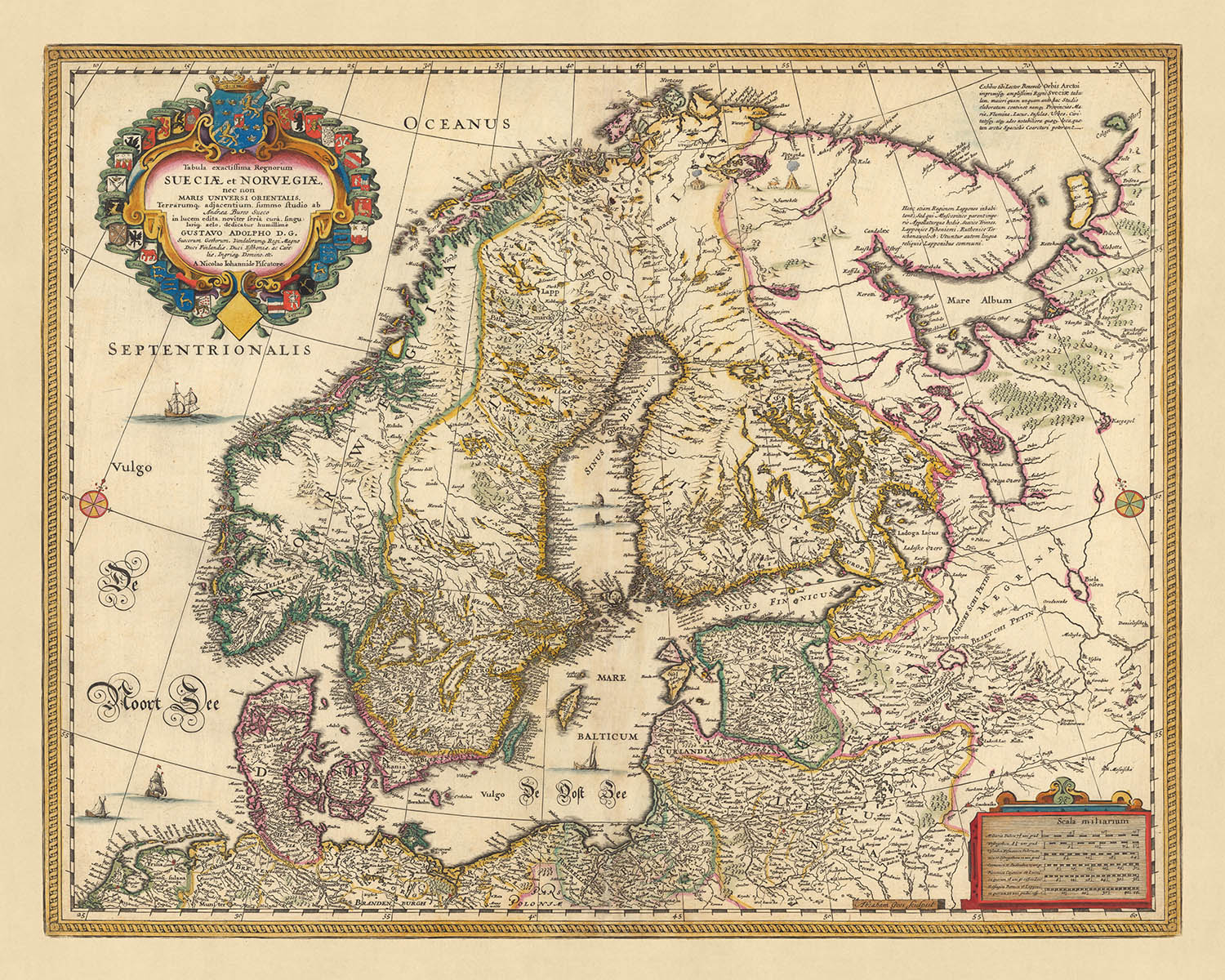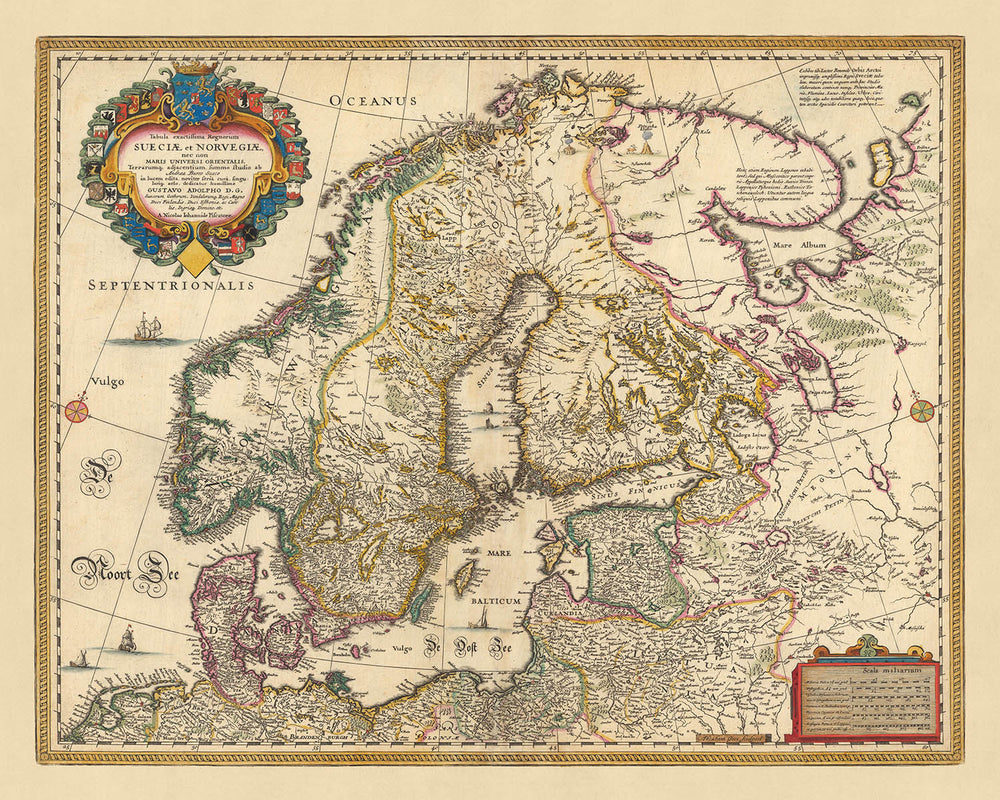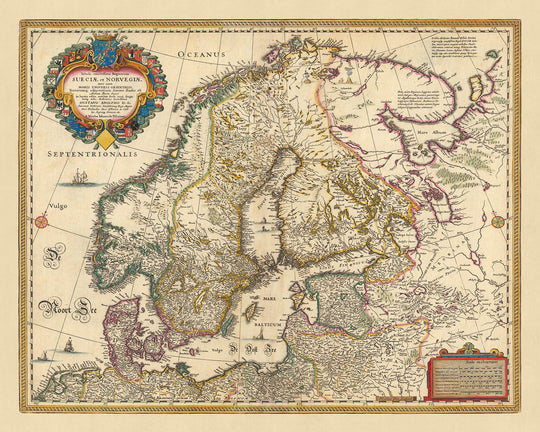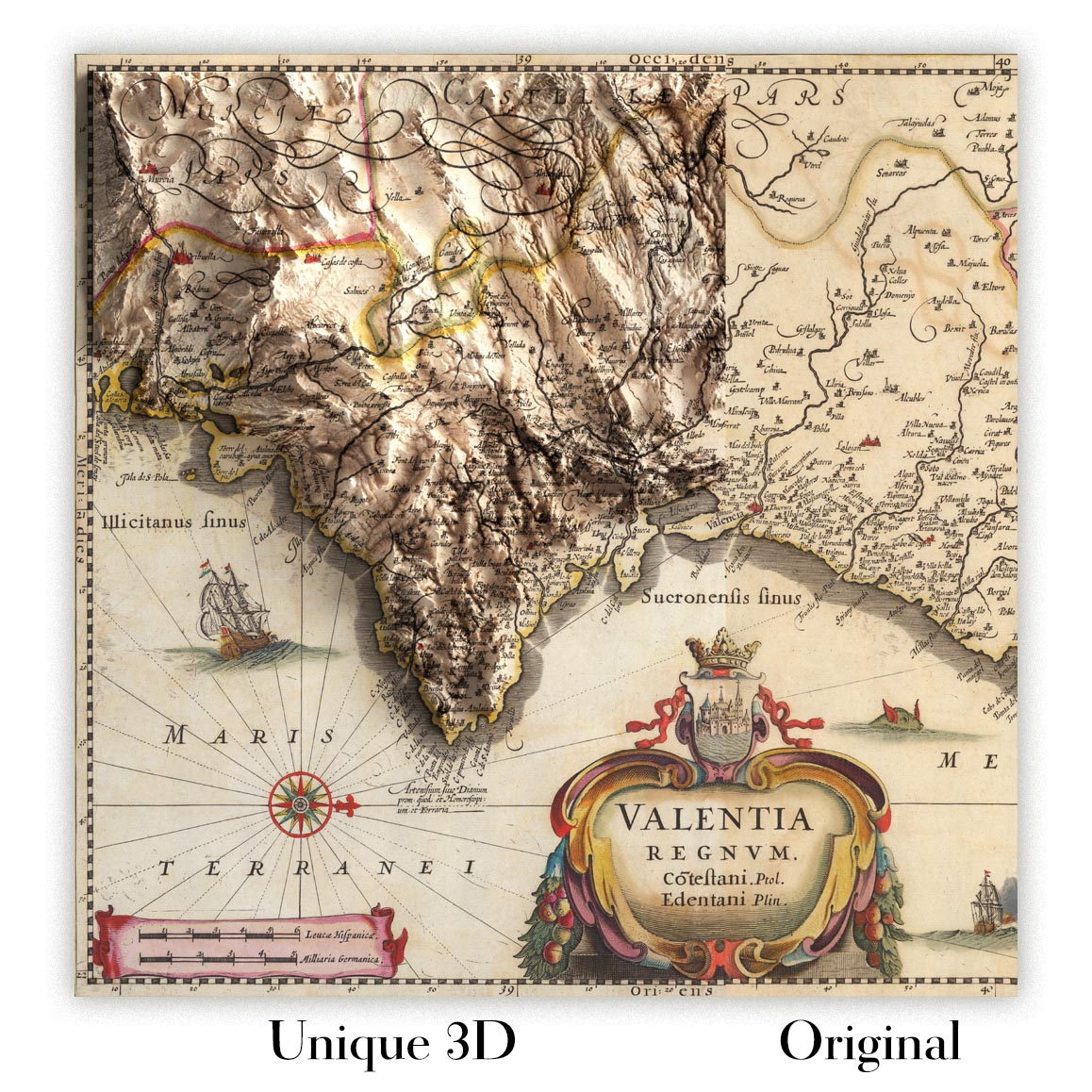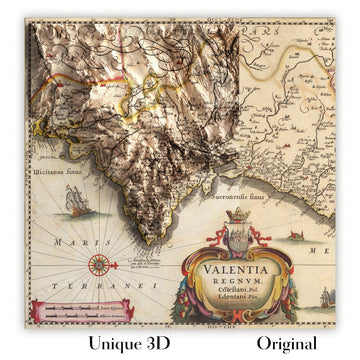- Handmade locally. No import duty or tax
- FREE Delivery by Christmas
- Love it or your money back (90 days)
- Questions? WhatsApp me any time
Own a piece of history
5,000+ 5 star reviews


This breathtaking map, titled 'Tabula exactissima Regnorum Sueciae et Norvegiae, nec non Maris Universi Orientalis Terrarumque adjacentium. Summo studio ab Andrea Bureo Sueco in lucem edita ... A Nicolao Iohannide Piscatore', was crafted by Nicolaes Visscher II in 1690. Visscher II was the grandson of Claes Janszoon Visscher, a renowned mapmaker during the Dutch Golden Age. The title translates to 'A very accurate map of the Kingdoms of Sweden and Norway, as well as the entire Eastern Sea and adjacent lands. With great diligence brought to light by the Swede Andreas Bureus ... by Nicolaes Visscher'.
The map's primary focus is Scandinavia and North Europe, covering the larger modern day area of Europe. It presents a detailed and accurate depiction of the region, showcasing the meticulous craftsmanship and cartographic knowledge of Visscher II. The intricacies of the political divisions and regions during the late 17th century are beautifully illustrated, providing a unique historical perspective.
The map features the cities of Oslo, Stockholm, Helsinki, Riga, and Copenhagen. Each city is depicted with remarkable precision, reflecting the urban landscapes of the time. The map also contains numerous other locations, each contributing to the overall historical and geographical narrative of the piece.
In addition to the cities, the map also includes significant landmarks and natural phenomena. The rugged Scandinavian mountain ranges, the expansive Eastern Sea, and the intricate network of rivers and waterways are all depicted with stunning detail. This map not only serves as a historical document but also as a testament to the natural beauty and diversity of the region.
This piece offers a fascinating glimpse into the past, making it a perfect addition for collectors, historians, and lovers of cartography. Its historical significance, combined with the craftsmanship of Nicolaes Visscher II, makes it a truly exceptional piece of art.
Some of the significant locations shown on this map:
Kingdom of Sweden
- Stockholm: Known as the "Venice of the North," it was the cultural, political, and economic hub of Sweden. Founded in 1252.
- Gothenburg: Founded in 1621, it became an important seaport in the Kattegat, on the west coast of Sweden.
- Malmö: Known as Malmhaug in 1275, it was a significant commercial and textile manufacturing center.
- Uppsala: Known for its cathedral and university, it was a significant center of ecclesiastical and educational activity. Founded in the 3rd century.
- Västerås: Founded in the 10th century, it was known for its copper and silver mines.
Kingdom of Norway
- Oslo: Known as Christiania until 1925, it was the capital of Norway. Founded in 1040.
- Bergen: Known as Bjørgvin in the Old Norse period, it was a significant center for trade in Norway. Founded in 1070.
- Trondheim: Known as Nidaros until the post-Reformation period, it was the traditional location for the coronation of kings. Founded in 997.
- Stavanger: Founded in 1125, it was known for its canning and shipbuilding industries.
- Drammen: Known as Bragernes until 1811, it was a significant river port. Founded in the 1811.
Eastern Sea and Adjacent Lands
- Helsinki: Founded in 1550, it was a trading town used to compete with Tallinn.
- Riga: Known as the "Paris of the North," it was a major center of the Hanseatic League. Founded in 1201.
- Tallinn: Known as Reval until 1918, it was a major trading and fishing port. Founded in 1248.
- Vilnius: Known as Vilna, it was a significant center of Jewish learning. Founded in 1323.
- Gdańsk: Known as Danzig until 1945, it was a major seaport and shipbuilding center. Founded in 997.
Notable natural phenomena and boundaries include:
- Scandinavian Mountain Range: This range forms a natural boundary between Norway and Sweden, and is a popular destination for hiking and skiing.
- Eastern Sea (Baltic Sea): It is the largest brackish water body in the world, and is surrounded by the Scandinavian Peninsula, mainland Europe, and the Danish islands.
- Gulf of Bothnia: This northern arm of the Baltic Sea forms a boundary between Sweden and modern-day Finland.
- Vänern and Vättern: These are the largest and second largest lakes in Sweden, respectively, and are popular for fishing and boating.
- Kjølen Mountains: These mountains form the natural boundary between Norway and modern-day Sweden.
Notable historical events in this region between 1600 and 1690 include:
- Thirty Years' War (1618-1648): Sweden's intervention in 1630 turned the tide of the war, establishing it as a major European power and expanding its territories.
- Second Northern War (1655-1660): This war resulted in the Treaty of Roskilde, where Denmark-Norway ceded significant territories to Sweden.
- Scanian War (1675-1679): This war ended with the Treaty of Lund, where Denmark-Norway and Sweden agreed to maintain the status quo, preserving Sweden's dominance in the region.
Please double check the images to make sure that a specific town or place is shown on this map. You can also get in touch and ask us to check the map for you.
This map looks great at all sizes: 12x16in (30.5x41cm), 16x20in (40.5x51cm), 18x24in (45.5x61cm), 24x30in (61x76cm), 32x40in (81.5x102cm), 40x50in (102x127cm), 48x60in (122x153cm) and 56x70in (142x178cm), but it looks even better when printed large.
I can create beautiful, large prints of this map up to 90in (229cm). Please get in touch if you're looking for larger, customised or different framing options.
The model in the listing images is holding the 16x20in (40.5x51cm) version of this map.
The fifth listing image shows an example of my map personalisation service.
If you’re looking for something slightly different, check out my collection of the best old maps of Europe and European cities to see if something else catches your eye.
Please contact me to check if a certain location, landmark or feature is shown on this map.
This would make a wonderful birthday, Christmas, Father's Day, work leaving, anniversary or housewarming gift for someone from the areas covered by this map.
This map is available as a giclée print on acid free archival matte paper, or you can buy it framed. The frame is a nice, simple black frame that suits most aesthetics. Please get in touch if you'd like a different frame colour or material. My frames are glazed with super-clear museum-grade acrylic (perspex/acrylite), which is significantly less reflective than glass, safer, and will always arrive in perfect condition.
This map is also available as a float framed canvas, sometimes known as a shadow gap framed canvas or canvas floater. The map is printed on artist's cotton canvas and then stretched over a handmade box frame. We then "float" the canvas inside a wooden frame, which is available in a range of colours (black, dark brown, oak, antique gold and white). This is a wonderful way to present a map without glazing in front. See some examples of float framed canvas maps and explore the differences between my different finishes.
For something truly unique, this map is also available in "Unique 3D", our trademarked process that dramatically transforms the map so that it has a wonderful sense of depth. We combine the original map with detailed topography and elevation data, so that mountains and the terrain really "pop". For more info and examples of 3D maps, check my Unique 3D page.
For most orders, delivery time is about 3 working days. Personalised and customised products take longer, as I have to do the personalisation and send it to you for approval, which usually takes 1 or 2 days.
Please note that very large framed orders usually take longer to make and deliver.
If you need your order to arrive by a certain date, please contact me before you order so that we can find the best way of making sure you get your order in time.
I print and frame maps and artwork in 23 countries around the world. This means your order will be made locally, which cuts down on delivery time and ensures that it won't be damaged during delivery. You'll never pay customs or import duty, and we'll put less CO2 into the air.
All of my maps and art prints are well packaged and sent in a rugged tube if unframed, or surrounded by foam if framed.
I try to send out all orders within 1 or 2 days of receiving your order, though some products (like face masks, mugs and tote bags) can take longer to make.
If you select Express Delivery at checkout your order we will prioritise your order and send it out by 1-day courier (Fedex, DHL, UPS, Parcelforce).
Next Day delivery is also available in some countries (US, UK, Singapore, UAE) but please try to order early in the day so that we can get it sent out on time.
My standard frame is a gallery style black ash hardwood frame. It is simple and quite modern looking. My standard frame is around 20mm (0.8in) wide.
I use super-clear acrylic (perspex/acrylite) for the frame glass. It's lighter and safer than glass - and it looks better, as the reflectivity is lower.
Six standard frame colours are available for free (black, dark brown, dark grey, oak, white and antique gold). Custom framing and mounting/matting is available if you're looking for something else.
Most maps, art and illustrations are also available as a framed canvas. We use matte (not shiny) cotton canvas, stretch it over a sustainably sourced box wood frame, and then 'float' the piece within a wood frame. The end result is quite beautiful, and there's no glazing to get in the way.
All frames are provided "ready to hang", with either a string or brackets on the back. Very large frames will have heavy duty hanging plates and/or a mounting baton. If you have any questions, please get in touch.
See some examples of my framed maps and framed canvas maps.
Alternatively, I can also supply old maps and artwork on canvas, foam board, cotton rag and other materials.
If you want to frame your map or artwork yourself, please read my size guide first.
My maps are extremely high quality reproductions of original maps.
I source original, rare maps from libraries, auction houses and private collections around the world, restore them at my London workshop, and then use specialist giclée inks and printers to create beautiful maps that look even better than the original.
My maps are printed on acid-free archival matte (not glossy) paper that feels very high quality and almost like card. In technical terms the paper weight/thickness is 10mil/200gsm. It's perfect for framing.
I print with Epson ultrachrome giclée UV fade resistant pigment inks - some of the best inks you can find.
I can also make maps on canvas, cotton rag and other exotic materials.
Learn more about The Unique Maps Co.
Map personalisation
If you're looking for the perfect anniversary or housewarming gift, I can personalise your map to make it truly unique. For example, I can add a short message, or highlight an important location, or add your family's coat of arms.
The options are almost infinite. Please see my map personalisation page for some wonderful examples of what's possible.
To order a personalised map, select "personalise your map" before adding it to your basket.
Get in touch if you're looking for more complex customisations and personalisations.
Map ageing
I have been asked hundreds of times over the years by customers if they could buy a map that looks even older.
Well, now you can, by selecting Aged before you add a map to your basket.
All the product photos you see on this page show the map in its Original form. This is what the map looks like today.
If you select Aged, I will age your map by hand, using a special and unique process developed through years of studying old maps, talking to researchers to understand the chemistry of aging paper, and of course... lots of practice!
If you're unsure, stick to the Original colour of the map. If you want something a bit darker and older looking, go for Aged.
If you are not happy with your order for any reason, contact me and I'll get it fixed ASAP, free of charge. Please see my returns and refund policy for more information.
I am very confident you will like your restored map or art print. I have been doing this since 1984. I'm a 5-star Etsy seller. I have sold tens of thousands of maps and art prints and have over 5,000 real 5-star reviews. My work has been featured in interior design magazines, on the BBC, and on the walls of dozens of 5-star hotels.
I use a unique process to restore maps and artwork that is massively time consuming and labour intensive. Hunting down the original maps and illustrations can take months. I use state of the art and eye-wateringly expensive technology to scan and restore them. As a result, I guarantee my maps and art prints are a cut above the rest. I stand by my products and will always make sure you're 100% happy with what you receive.
Almost all of my maps and art prints look amazing at large sizes (200cm, 6.5ft+) and I can frame and deliver them to you as well, via special oversized courier. Contact me to discuss your specific needs.
Or try searching for something!







